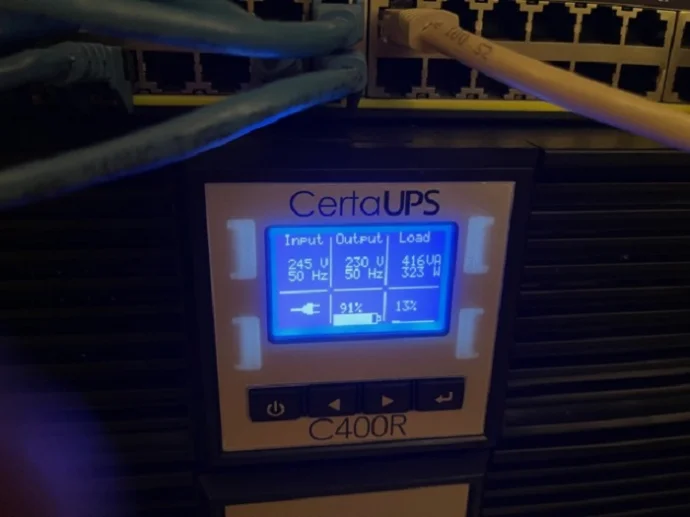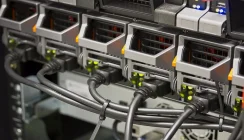How to Plan A Rackmount UPS Installation
Computer and small server rooms tend to only have one or two server racks to protect from power outages. For these installations, a rackmount UPS if often the preferred solution. There are some factors to consider when planning to install an uninterruptible power supply in a server rack which do not apply to a floor standing tower system.
Server Racks
Server racks or data cabinets, as they are sometimes known, can be sized based on their height, depth, and width. The internal height of a server rack is measured in U where 1U = 44.45mm. This is a standard industry rack height measurement and allows IT managers to calculate the total height required of all the equipment that will be rack mounted. A server may be 1 or 2U, a UPS 1U or 3U for example.
The depth of a server rack is the next most important consideration. The typical industry standard depths are 600mm, 800mm, 900mm, 1000mm and sometimes 1200mm. This is the outer depth of the cabinet. The internal ‘usable’ depth may be short. For example, in a 600mm cabinet the maximum internal depth is only 470mm and in an 800mm rack 670mm. The maximum internal depth available restricts amount of space available to equipment that will be mounted in the cabinet. For example, a 500mm deep rack will require an 800mm deep rack. It is important also to allow for cable radius bends when selecting a rack depth.
The standard internal industry width for a rack is 19inches (483mm) but the external rack dimension will be either 600mm or 800mm. Both will house 19inch rack mount devices. The 800mm rack just has more room on the rides after the internal struts for cabling and/or air flow.
In existing comms and server rooms, the racks may be already available. If so their physical dimensions in terms of depth, and height available should be considered, when choosing a rack mount UPS solution.
Server Rack UPS Load Sizing
To correctly size an uninterruptible power supply, it is important to calculate the total IT load it is to power. This can be calculated by summing the VA (Volts x Amperage) of all the individual IT devices. Volts refers to the mains supply voltage which is the UK for a single-phase supply is 230V (50Hz). The Amperage is the current drawn by the IT loads and this again can be totalled. Alternative the Watts to be drawn can be totalled for each device. Watts and/or Amps are shown on the rear rating plates of the devices or on data sheets or in manuals.
When the total VA or Watts is known, it is important to add a growth factor of 20% to arrive at the total load to be powered by the UPS i.e., total VA or Watts x 1.2 = maximum UPS load. Twenty percent provides a safety margin and room for load expansion.
The nearest sized UPS can then be chosen i.e., if the total load is 1.8kVA, then a 2kVA UPS should be installed.
UPS Topology
For a rack UPS two types of technology should be considered: line interactive and online UPS. An online UPS is the preferred type as the output waveform is a sinewave and the inverter section constantly powers the load unless the automatic bypass is activated. This feature allows for safe failure-to-mains power if the UPS is overloaded or develops a fault condition and prevent an IT load crash. A line interactive UPS can also have a sinewave inverter but by design will not include an automatic bypass. Either type is suitable for a server rack installation and IT load protection with the online being the preferred choice.
UPS Battery Runtimes
Runtime is the duration that the UPS is expected to run on battery power when there is a power outage or prolonged mains power supply failure. 10-30minutes is considered sufficient to ride out most power outages and provide sufficient time for an orderly shutdown. If a longer period is required, then this must be provided by a larger battery set or a local standby power generator.
Most rack mount UPS below 3-4kVA have internal batteries. Longer runtimes and larger loads tend to require external battery trays. For a server rack installation, the greater the number of battery trays required, the more U height will be taken up by the UPS system and the less will be the space available for IT loads.
A point here should be made re health & safety. Rack mount UPS and battery trays should only be inserted into a rack or removed following a risk assessment to ensure any risks are removed. A UPS can weigh up to 20Kg and battery packs even more. Two people are typically required to place a UPS system in a server rack or remove it, and a lifting table may be required. The UPS and battery trays themselves will typically sit on runners provided by the UPS manufacturer.
Critical Power Distribution
Uninterruptible power supplies for small server racks will have IEC320 10A sockets or outlets. This allows an IEC320-to-IEC320 power cable to be used to connect the IT loads to the UPS. Where there are more load connections than outlets available, a power distribution unit (PDU) may be required. More outlet connections may be required where a server has a dual power supply requiring A and B supplies.
Network Interface Cards
A UPS will provide operational status information from its front panel display. A slot-in SNMP interface card allows the UPS to be remotely monitored and controlled over an IP network and for alarms to be broadcast. Most single-phase rack mount UPS will have a built-in communications slot into which an SNMP or MODBUS card can be installed.
UPS Bypass Arrangements
A maintenance bypass allows an uninterruptible power supply to be bypassed for maintenance without disruption to the connected loads. In comms and server rooms, where the IT network cannot be brought down i.e., 24/7 operation, a UPS maintenance bypass can be installed. The bypass may be wall mounted or 19inch rackmount. In the latter case, the installation will take-up additional U height in the server rack.
Automatic Transfer Switches (ATS)
ATS switches can provide another level of resilience to a rack UPS installation. An ATS has two inputs (primary and secondary) and either can be automatically or manually selected to power the connected load. The primary can be UPS power and the second, the mains power supply.
Summary
Planning for a rackmount UPS installation is similar that for a floor standing tower system with the exception being how and where to install the UPS system within the chosen rack and arrange the power distribution to the critical IT loads. A well planned and installed rackmount UPS will make it easier to maintain and add additional loads to. The use of a UPS maintenance bypass is recommended to prevent load disruption when the UPS is serviced and given the nature f the installation, connection of the UPS to the local IP network via an SNMP card for monitoring.


























